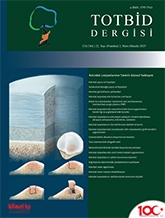
Articular cartilage is a tissue that covers the bone surface in diarthrodial joints with a thickness of 0,5-5 mm, provides the transfer of load between the bones and allows the movement of the joint in planty of axes. Cartilage tissue, unlike other tissues, is hypocellular and does not contain cells other than chondrocyte. Many cartilage-specific collagen and proteoglycans and the matrix supporting this structure form the very special tissue of the articular cartilage. It has a very limited healing capacity in case of injury due to the absence of vascular, lymphatic and nervous structure and its direct nourishment from the synovium and subchondral bone, although it has been functioning effectively for about mean human lifespan of 80 years. The main component of cartilage, of which more than 70% is water, is type 2 collagen, and it provides structural support by interacting with other collagens and non-collagenous proteins. In the cartilage structure, which is histologically divided into four regions, the percentage and location of water, cells and collagens in each region varies. Chondrocytes are responsible for cartilage production and sustainability, which begin to regress with advancing age, which paves the way for joint disorders such as osteoarthritis. Therefore, it is important to know the cartilage structure in order to ensure the continuity of cartilage health.